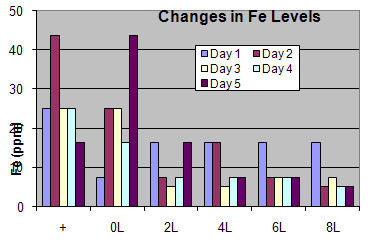|
|
|
|||||||||||||||||||||||||||||||||||||||||||||||||||||
|
% of Water Lost:
|
+ | 0L | 2L | 4L | 6L | 8L |
| Trial 1 | -53.03 | -63.87 | -69.16 | -70.62 | -73.6 | -69.09 |
| Trial 2 | -50.62 | -32.65 | -29.88 | -34.62 | -32.93 | -28.89 |
| Trial 3 | -48.45 | -28.65 | -30.91 | -27.61 | -31.52 | -32.78 |
| Trial 4 | -40.71 | -33.23 | -38.34 | -33.76 | -32.69 | -30.97 |
|
Trial 5
|
-44.14
|
-32.11
|
-31.64
|
-41.49
|
-32.36
|
-35.49
|


Once you have completed these charts, it would be helpful to set up a graph for each of the tables you have set up. For each topic, you need to make two graphs. One graph should consist of all of the numbers, the other graph should consist of the averages of all the days so that there is only one number per amount of water. In this example, there are two graphs. The first graph shows the levels of iron for each day, the second graph shows the averages of all the days for each level of water.